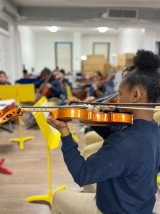-
Category 2
Selected in 2022
-
Grades: k - 9
School Setting: urban
Town Population: 285
Student Enrollment: 640
Student Demographics:
Black/African American: 25%
Teacher/Student Ratio: 1:15
White/Caucasian: 0%
Hispanic: 70%
Hawaiian/Pacific Islander: 0%
Asian: 0%
Native American: 0%
Other: 5%
% Reduced Lunch: 95%
% ELL Learners: 40%
Founded: 1997 -
PRINCIPAL:
Alex Quigley -
CONTACT:
807 W. Chapel Hill St.
Durham, NC 27701
919-956-5599
aquigley@durhamcharter.org
Durham Charter School
Durham, NC
"Our goal is to prepare our students for success in college or careers."
- 1. Tell us about your school’s success.
-
Founded in 1997, Durham Charter School (formerly Healthy Start Academy) serves 625 students between two campuses near downtown Durham. 95% of our students qualify for free and reduced lunch. In 2020, the North Carolina State Board of Education awarded Durham Charter (formerly Healthy Start Academy) a 10-year charter - the longest term possible for NC charter schools.
Our Mission is “To deliver services through a coordinated, comprehensive, forward-looking approach to educate our diverse student body by developing skills and talents in order to help them make a positive contribution in our global society.” Our Goal is “To prepare our students for success in college or career.”
Durham Charter has undergone a dramatic transformation over the last five years from a chronically low-performing school, to posting the #10 highest growth out of 2,500 schools in North Carolina.Durham Charter is now the 3rd highest performing charter in Durham as determined by academic proficiency standards.
- 2. Talk about the greatest contributing factor(s) that promoted positive change in your school.
-
Three factors have been instrumental to our success over the past 2-3 years. First, we have prioritized student culture, by aligning our systems and routines to ensure no learning time is wasted and everything in our building supports a focus on academics. Second, we have implemented a intensive coaching model to train teachers in best practices. Teachers are observed on a weekly and even daily basis and provided specific coaching feedback. Finally, we've implemented a framework for data driven instruction that utilizes weekly data meetings, looking a student work protocols, and a six week cycle of re-teaching.
In addition to these techniques, we used ESEA funds to add teacher residents at each grade level to provided targeted intervention and build our bench for long-term lead teacher positions. This model has proved critical to meeting student needs and ensure consistent instruction.
- 3. How has ESEA funding supported the school's success?
- ESEA funding has been instrumental in funding our teacher resident program, as well as funding curricular supports. Perhaps most importantly, it enabled us to hire instructional coaches who played a critical role in providing daily coaching, support, and training on curriculum. Our instructional coaches provide the leadership and support necessary to ensure implementation of our model.
- 4. What professional development activities were used to improve teaching and learning?
-
Most of our professional development happens through weekly planning and data meetings, where teachers look a standards, conduct individual item analysis, and participate in looking at student work protocols. It's in these meetings that teachers get to analyze standards, student performance, and make plans to address gaps. This professional development is job embedded and actionable.
Additionally, we relied on Teach Like a Champion modules. Additionally we utilize the frameworks found in Paul Bambrick-Santoyo's books Driven by Data and Leverage Leadership. Our leaders have been deeply trained in these practices and then coach teachers on their implementation.
- 5. Talk about the cultural shift leading up to your school's success.
- Our school has made a dramatic turnaround. The shift started with defining a clear, coherent, consistent culture of high-expectations that needed to permeate every aspect of the school's work. After establishing that new vision, we inspected all areas of the school's systems, working to identify obstacles to creating a positive school culture where learning could flourish. Every small thing counts in a school setting and communicates expectations to students, so nothing was overlooked. One example, existing procedures for student arrival were initially very weak, leading students to have to wait in lines off the bus and for breakfast. This breakdown sent a clear message that student time was NOT a priority. We immediately overhauled all aspects of arrival to ensure scholars never wait in line, are greeted multiple times in positive language, and begin work efficiently. These adjustments have deeply altered the culture, communicating to our scholars that every day begins with focus.
- 6. How has community involvement strengthened your success?
- We've developed key partners in the community to support the learning program. For example, we partnered with KidzNotes, a community based organization dedicated to eradicating poverty through music, to provide free daily music violin instruction for students. We've also developed a program with North Carolina Central University to provide young Black male mentors for our middle school boys. By engaging local partners we've been able to catalyze higher engagement and support from families.
Stats
-
Category 2
Selected in 2022
-
Grades: k - 9
School Setting: urban
Town Population: 285
Student Enrollment: 640
Student Demographics:
Black/African American: 25%
Teacher/Student Ratio: 1:15
White/Caucasian: 0%
Hispanic: 70%
Hawaiian/Pacific Islander: 0%
Asian: 0%
Native American: 0%
Other: 5%
% Reduced Lunch: 95%
% ELL Learners: 40%
Founded: 1997 -
PRINCIPAL:
Alex Quigley -
CONTACT:
807 W. Chapel Hill St.
Durham, NC 27701
919-956-5599
aquigley@durhamcharter.org







